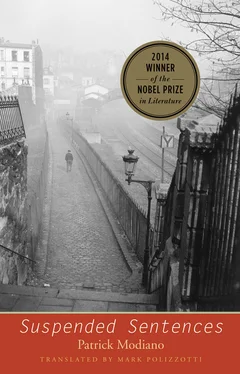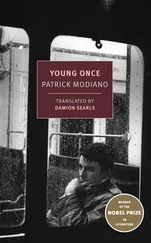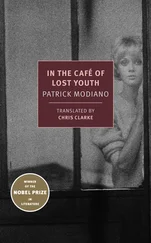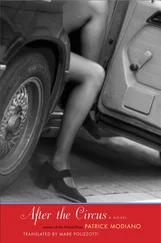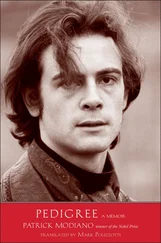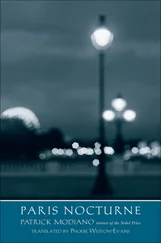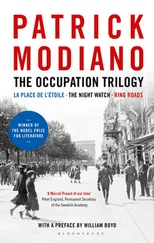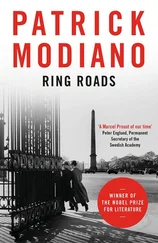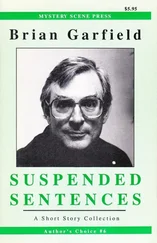Those areas looked the same to me as when I’d last seen them in the early sixties, as if they’d been abandoned at around the same time, more than twenty-five years ago. On Rue Gay-Lussac — that quiet street where once they’d pried up the cobblestones and erected barricades — the door of a hotel was boarded up and most of the windows were missing their panes. But the sign remained affixed to the wall: Hôtel de l’Avenir. Hotel of the Future. What future? The one, already past, of a student from the 1930s who took a small room in that hotel after graduating from the Ecole Normale Supérieure, and who on Saturday nights would have his friends over. They would go around the corner to watch a film at the Studio des Ursulines. I walked by the gate and the white shuttered building, in which the cinema occupies the ground floor. The entryway was lit. I could have walked to the Val-de-Grâce, in that peaceful zone where we had hidden, Jacqueline and I, so that the marquis would have no chance of finding her. We lived in a hotel at the end of Rue Pierre-Nicole. We subsisted on the money Jacqueline had gotten from selling her fur coat. The sundrenched street on Sunday afternoons. The privet hedges of the small brick building opposite the Collège Sévigné. The hotel balconies were covered in ivy. The dog napped in the entrance hall.
I reached Rue d’Ulm. It was deserted. Though I kept telling myself that there was nothing unusual about that on a Sunday evening in this studious, provincial neighborhood, I wondered whether I was still in Paris. In front of me, the dome of the Pantheon. It frightened me to be there alone, at the foot of that funereal monument in the moonlight, and I veered off into Rue Lhomond. I stopped in front of the Collège des Irlandais. A bell tolled eight o’clock, perhaps the one at the Congrégation du Saint-Esprit, whose massive façade rose to my right. A few more steps and I emerged onto Place de l’Estrapade. I looked for number 26 on Rue des Fossés-Saint-Jacques. A modern building rose before me. The old one had probably been torn down a good twenty years earlier.
April 24, 1933. A young married couple commits suicide for no apparent reason.
It’s a very strange story that occurred that night in the building at number 26 Rue des Fossés-Saint-Jacques, near the Pantheon, in the home of Mr. and Mme T.
Three years earlier, Monsieur Urbain T., a young engineer, top in his class, had married Mademoiselle Gisèle S., age twenty-six, one year his senior. Mme T. was a pretty blonde, tall and svelte. As for her husband, he was the typical dark and handsome young man. The previous July, the couple had set up house on the ground floor of 26 Rue des Fossés-Saint-Jacques, in a former workshop that they had converted into a studio apartment. The young newlyweds were very close. Nothing seemed to be clouding their happiness.
One Saturday evening, Urbain T. decided to take his wife out to dinner. They both left the house at around seven. They wouldn’t return home until about two in the morning, along with two couples they’d just met. The unusual din from their apartment woke the neighbors, unaccustomed to such a racket from tenants who were ordinarily so quiet. No doubt the party took a few unexpected turns.
At around four in the morning, the guests departed. During the half-hour that then passed in silence, two muffled explosions sounded. At nine o’clock, a neighbor, leaving her own apartment, passed in front of the couple’s door. She heard moaning. Suddenly remembering the shots heard in the night, she grew worried and knocked. The door opened to reveal Gisèle T. Blood was slowly leaking from a visible wound beneath her left breast. She murmured, “My husband! My husband! Dead.” A few moments later, Detective Magnan of the local police appeared on the scene. Gisèle T. was moaning, lying on the couch. In the next room, they discovered the body of her husband. The latter was still clutching a revolver in his hand. He had shot a bullet straight through his heart.
Beside him, a scribbled note: My wife killed self. We were drunk. I kill self. Don’t try …
From the police report, it appears that Urbain and Gisèle T., after their dinner out, found their way to a bar in Montparnasse. The other evening, from Rue des Fossés-Saint-Jacques, I walked to the intersection where the Dôme and the Rotonde stand, after leaving behind the dark gardens of the Observatoire. The T.’s must have followed the same path, that night in 1933. I was surprised to find myself in a place I’d avoided since the early sixties. Like the Studio des Ursulines, the Montparnasse neighborhood always reminded me of Sleeping Beauty’s castle. I had felt the same thing at age twenty, when I spent a few nights in a hotel on Rue Delambre: Montparnasse already seemed like a quarter that had outlived itself and was slowly decaying, far from Paris. When it rained on Rue d’Odessa or Rue du Départ, I felt as if I were in a Breton port in the drizzle. The old train station, which hadn’t yet been demolished, exhaled gusts of Brest or Lorient. Here, the party had long been over. I remember that the sign for the long-vanished Jimmy’s was still clinging to the wall on Rue Huyghens, and that it was missing two or three letters which the sea breezes had blown away.
It was the first time — according to the newspapers in April 1933—that the young couple had set foot in a Montparnasse nightspot. Had they had a bit too much to drink with dinner? Or else, quite simply, had they felt like disrupting, if only for a night, the tranquil course of their lives? One witness swore he’d seen them at around ten o’clock in the Café de la Marine, a dance hall at 243 Boulevard Raspail; another, at the Cabaret des Isles on Rue Vavin, in the company of two women. The detectives showed their photos around to solicit statements, which had to be taken with a grain of salt, since one saw plenty of blonde girls with dark-haired boys, like Urbain and Gisèle T. For several days they tried to identify the two couples that the T.’s had brought home with them to Rue des Fossés-Saint-Jacques, then the investigation was closed. Gisèle T. had been able to talk before succumbing to her injuries, but her memories were hazy. Yes, they had met two women in Montparnasse, two strangers she didn’t know much about … And those two had taken them out to Le Perreux, to a dance hall where two men had joined them. Then they’d gone to a house with a red elevator.
This evening, I’m following in their footsteps in a sullen quarter that the Tour Montparnasse veils in mourning. During the day, it hides the sun and throws its shadow onto Boulevard Edgar-Quinet and the surrounding streets. I leave behind me the Coupole, which they’re smothering under a concrete façade. It’s hard to believe that Montparnasse used to have any nightlife …
In what period, exactly, did I live in that hotel on Rue Delambre? Around 1965, when I met Jacqueline, not long before my departure for Vienna.
The room next to mine was occupied by a man of about thirty-five, a blond fellow I’d sometimes meet in the hall and who I ended up getting to know. His name? Something like Devez or Duvelz.
He was always nattily dressed and wore an official decoration on his lapel. Sometimes he invited me out for a drink, at a bar right near the hotel, the Rosebud. I didn’t dare refuse. He seemed enchanted with the place.
“It’s very pleasant here …”
He spoke from the tip of his teeth, with the voice of a well-heeled scion. He confided to me that he’d spent more than three years “in the djebel” and that he’d earned his decoration over there. But the Algerian War had sickened him. He’d needed a long time to get over it. Very soon he was going to take over for his father as head of a large textile concern in the North.
Читать дальше
